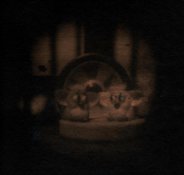crystalclear
Member
- Joined
- Apr 30, 2008
- Messages
- 30
- Format
- 35mm
I know most people think its either impossible or highly impractical due to extreme exposure times, but I did find one person who has successfully produced cyanotype photgraphs with a camera. Most are full day exposures, but they are interesting.
Heres the link!
http://www.tompolk.com/hobbies/cyanotype/cyanotype.html
CrystalClear
Heres the link!
http://www.tompolk.com/hobbies/cyanotype/cyanotype.html
CrystalClear














